Before the Mach-E, before the Bolt, before the Model 3 there was … the Nissan Leaf. Small with limited range and an awkward exterior, the Leaf was the first mainstream electric vehicle. Since then, the OG EV has been pushed to the back of the line; however, the 2026 Nissan Leaf Premium+ is making a statement: I’m back.
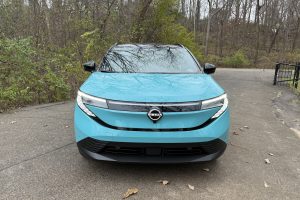
The all-new 2026 Nissan Leaf is a massive change from the OG model that ushered in EVs to the mainstream.
Well, after a week in the new model, it’s tough to say it’s “back,” but it’s easy to say, it’s pretty good! No longer a hatchback, the crossover boasts an entirely new look. It’s been a long time since the word “quirky” applied to the Leaf, but the new design is a departure and an improvement over the previous model.
A new year and a new look
It’s a smoother, curvier body with clean lines, accented by the slit-like headlamps that are de rigueur these days. The front fascia is made to look wider and more aerodynamic with the black molding that houses the headlamps and supplemental lighting. That look is really accentuated with the Seabreeze Blue Pearl and Super Black combo that our tester came in. I’m not sure any other color pairing is as impacted by the look.
When you follow the curving roofline back, Nissan officials claim that’s inspired by the Nissan Z, but I’m not seeing that in as much as I see a smaller version of the recently suspended Nissan Ariya EV. Still, it’s a clean look and gives the Leaf a flowing profile.
That feel is enhanced by the integrated window glass and the rear fenders that rise up to meet a sloping rear window. The 45-degree liftgate spoiler rounds out the design while adding some function. The Leaf looks … slippery. And that’s because it is, achieving a drag coefficient of just 0.26, and improvement over the previous model’s 0.29.
Just to have some fun, Nissan designers incorporated “2-3” iconography consisting of two rectangles paired with three perpendicularly aligned rectangles. This references the company’s name, with “2-3” pronounced “ni-san” in Japanese. The graphic is seen in the headlights and tail lamps, the wheel designs and subtly incorporated into the cabin, to reference the company’s history and identity.
Impressive performance
Again, the history of the Leaf is not one filled with references to performance. But the Premium+ is more than spunky, it’s fast … at least compared to other gas-powered compact crossovers. The Premium+ battery-electric drivetrain puts out 214 horsepower and 261 lb-ft of torque.
That may not seem like earth-shattering numbers, especially when compared to other EVs. However, in this setup, you get a zippy, responsive vehicle that is fun to drive and you don’t see the battery gauge slide toward the negative each time you put your foot into it. It handles nicely through curves with a minimum of body roll while the regen-braking with e-Step isn’t quite one-pedal driving, but it’s very convenient.
It comes with a 75 kWh lithium-ion battery and a NACS (Tesla-style) charge port on the passenger side of the vehicle and a J1772 on the driver’s side which is good for most Level 2 chargers as well as at home charging. It’ll charge at speeds up to 150 kW using a Tesla Supercharger. It is not blindingly fast, but you won’t be stuck forever waiting to juice up.
You can also use Nissan’s own charge network, the Nissan Energy Charge Network, which works with the MyNissan app, allowing drivers to find Nissan chargers, give real-time availability updates and pay for charging.
Plenty of space
The cabin of the new Leaf is a study in balance. It’s spacious and simple, but not spare. It’s impossible to miss the two massive 14.3-inch screens that bring you all of the info you need to pilot the Leaf, but overall design is uncluttered. Airy is the word so many automakers use to tout their interior space, but the simplicity of the design felt … calming.
Often when you climb into an EV or even a hybrid, your senses are assaulted by buttons, screens, and other whatnot. This isn’t the case in the Leaf Premium+. Nissan uses the word “minimalist,” and I’m going to agree with them. The easiest example the the piano-style buttons used to select what gear you need. They sit, essentially, by themselves. You’re not going to accidentally put the car into gear while selecting a radio station or by adjusting the cabin temperature.
That kind if spaciousness translates to other parts of the car. It’s room, even in the back seat where I had plenty of room to sit comfortably. You could spend several hours without complaint in the second row … at least if you shorter than about 6-foot, 2-inches tall.
The cabin’s bright due to large windows and the panoramic roof. However, if it’s too bright, you can make it opaque at the touch of a button, a nice feature on a sunny day. Plus if you need to haul anything around, there’s 55 cubic feet of space in the cargo area behind the second row. It’s a very usable vehicle.
Tech savvy
The aforementioned 14.3-inch screens are the heart of the Leaf’s technology, which relies on Google built-in, including Google Maps, Google Assistant and Google’s Play Store. However, if you prefer to use Apple CarPlay or Android Auto, those are available as well.
On the Platinum+ model we drove, the Bose Personal Plus sound system proved to be a great companion during all of my excursions. It comes with 10 speakers, including those mounted in the front headrests. The sound, whether ’80 Alternative or my favorite podcasts, was clear and crisp. Music sounds full and rich after you tweak the settings to your personal preferences.
There are four USB-C charging ports available — two front and back — as well as wireless charging pad stationed in the console armrest. I love this location because its easy to access and ensures the phone stays centered on the pad, ensuring continual charging.
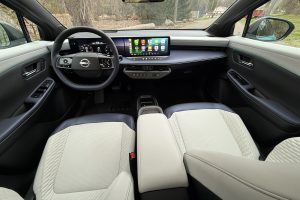
Nissan ensures all occupants in the Leaf are as safe as they can be with its Safety Shield 360 suite of safety tech plus its ProPILOT Assist technology.
Nissan ensures all occupants in the Leaf are as safe as they can be with its Safety Shield 360 suite of safety tech plus its ProPILOT Assist technology that offers Intelligent Cruise Control as well as Secondary Collision Mitigation Braking, which applies the brakes to help reduce the severity of or prevent a secondary crash into another vehicle or hazard when the airbags deploy.
Bottom line
Automakers focus on range and style when it comes to EVs these days and Nissan’s done a good job with the Leaf. However, it’s a bit compromised when it comes to the styling inside and out for many.
The Premium+ we tested came in at $41,930, with a range of about 300 miles (303 officially). It’s much improved, and I enjoyed my week in it, but it’s not for me.


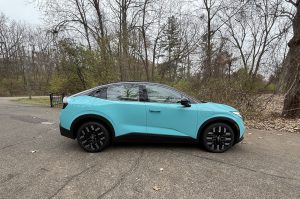
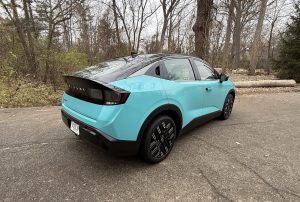


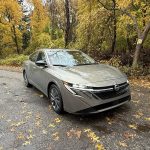


0 Comments